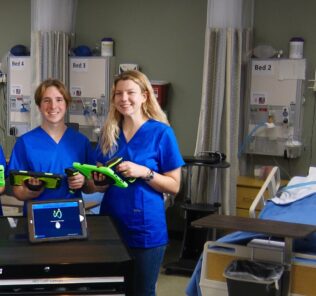Healthcare Simulation Escape Room Tips & Tricks Part 2
Escape rooms are an effective and engaging way to review concepts and knowledge in healthcare education, and a novel way to introduce learners to healthcare equipment and supplies. This HealthySimulation.com article is the second in a three-part series (read Part I here) that discusses space considerations as well as tips and tricks specifically for selecting and using various locks to create a successful escape room healthcare simulation experience. Specifically, this healthcare simulation article addresses details such as how to choose and use various bags, boxes, and other containers in an escape room. Further, the article shares ideas for incorporating the use of medical equipment and supplies into a clinical simulation curriculum.
Choosing Boxes, Bags, and Other Containers
There are a few important things to consider when choosing containers to place clues, answers to clues, or other items for participants to use to complete their escape. First, consider the durability of the containers. If using some kind of bag, the bag needs to be sturdy.
Sponsored Content:
This is especially true if participants are being timed. They will not necessarily use care when opening the bags if they are rushing, and I personally have never used bags (of any kind) for this reason. Bags are also difficult to adequately close so that participants do not “cheat” and get to the contents without opening the lock.
Cardboard boxes are easier to securely close and can be more durable than bags. In order to stand up to the wear and tear of repetitive use, they should be thick, coated boxes like those often used as packaging for medical and computer equipment. Otherwise, regular brown cardboard boxes can be used but I suggest reinforcing them with packing tape to extend their durability.
Plastic containers, even those obtained at a dollar store, are far more durable. The most important tip is to check the strength of the hinge. Anticipate wear and tear and consider a box with a separate lid if concerned. This type of lid can be secured with zip ties placed through holes to make a hinge.
Containers come in just about any size. Some items such as medical equipment or supplies may require a larger box such as a shoe box. If a medical simulation space or environment is small or the simulationists are hiding boxes for participants to look for, smaller boxes may be necessary.
Sponsored Content:
There are other interesting containers in which to hide clues, combinations, or keys such as medication bottles, a shoe, a mailbox, or even a shirt pocket. Be creative. Just be sure the container is secure enough to ensure learners cannot get to the contents without opening the lock.
Another insight to consider, especially when choosing plastic boxes, is opacity. Be sure participants cannot see the item or clue that is within the box unless you want them to. An example of when a see-through box is beneficial is when the use of a particular item, such as a black light or piece of medical equipment – such as a laryngoscope – is needed.
Participants could recognize the need for the item, see it locked in a box but then have to figure out what information is needed to solve a puzzle to give them the code to open the lock on that box. If using a box that is see-through, and the simulationist doesn’t want participants to see inside, they should conceal the contents by lining the inside of the box with paper.
I often need to do this when I use the boxes to conceal the next clue. Otherwise, eager learners will just lift the box and read through the bottom if able.
Incorporating the Use of Specific Equipment
When one of the objectives in the room involves familiarization with the operation of or content within a particular piece of equipment, consider using that as your “container.” An example of this would be code cart orientation. After directing the learners to the code cart (i.e. by using a clue or by having a manikin that requires resuscitation), offer puzzles, questions, or clues within each drawer of the code cart. As the team works through the drawers, solves the puzzles, answers the questions, or completes activities, they can earn puzzle pieces that reveal a code once put together. Playing cards can also be used, once placed in the correct order, to make the combination unlock another lock.
In a recent code blue escape room I facilitated, I recognized that learners notoriously forgot to apply gloves prior to performing CPR. Playing cards were being used to give the final combination to a prize box containing rewards for the learners (candy, ChapStick, pencils, etc.).
I hung one of the four cards on the glove box so that they would need to look around the room, find the card and subsequently recognize that they neglected to apply gloves. Learners who did remember to apply gloves appropriately were rewarded by finding the card right away, so this placement served a purpose either way.
Another fun example of incorporating the use of medical equipment is to require participants to recognize or determine proper medication dosing. They can super glue the plungers within the barrels of syringes at specific dosages, such as insulin syringes, code med syringes, or other medications requiring titration or calculation. Learners must determine the correct dosing in the proper order. Tape a letter to each syringe that aligns with a letter on a lock. Once learners figure out the proper doses, the syringes would be arranged in the order needed to unlock the accompanying lock to reveal the next clue or item.
Many medications and types of syringes could be interchanged for this depending on the theme. For example, a maternity-themed room could require learners to use pregnancy-induced hypertension (PIH) treatment protocol of administering 20 mg, then 40 mg, then 80 mg of intravenous Labetalol.
To make this process harder, simulationists could include some “wrong dose” syringes as well. A pediatric-themed room could include weight-based dosing challenges. Insulin sliding scale administration for various glucose readings also lends itself well to this type of puzzle.
Final Thoughts
Unlike commercial escape rooms, simulationists and healthcare simulation educators often do not have the luxury of time. The escape room activity is usually scheduled into one laboratory or lecture block. Because of this, timing must be carefully planned. The activity will not be an effective learning opportunity if learners are not able to finish. Be sure to not make the challenges so difficult that this will delay the participants so much that they end up permanently stuck.
Consider this: Four numbers can have 24 possible permutations. Be sure participants have a reference to guide their answers. Also, to ease setup when conducting several sessions in a row, consider purchasing multiples of the same boxes and containers so that the room can be duplicated. This will especially help when a replacement is quickly needed because one container was lost or broken. Take pictures of the room so that the placement where everything belongs is clear and can be stored within the boxes.
Disclaimer: Views expressed here are solely those of the author and do not represent those of any employer or organization.
Read Healthcare Simulation Escape Room Tips & Tricks Part 1
Michelle Sherlin, RN, BSN, CHSE, is the full-time coordinator of the 18-bed simulation lab at the Holyoke Community College Center for Health Education and Simulation. She has patient simulation experience dating back to 2002 when she started healthcare simulation at a vocational school and progressed to implementing simulation activities for several area schools and health care facilities. Her background includes curriculum development at the high school and college levels. Sherlin has hosted patient simulation-related conferences and presented on a multitude of topics. She stays current in nursing practice by working as a staff nurse in the Emergency Department. Sherlin is a per diem educator for the same facility where she conducts patient simulation and teaches Advanced Cardiac Life Support. She also works for a community partnership at another local hospital. In that position, she implements a variety of programs to introduce students to various health care professions. She recently won the “Excellence in Clinical Simulation” award from Education Management Solutions.
Sponsored Content:




















